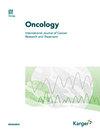The usefulness of serum interleukin-6 as a predictor of response to atezolizumab plus bevacizumab combination treatment in hepatocellular carcinoma.
IF 2.5
3区 医学
Q3 ONCOLOGY
引用次数: 0
Abstract
INTRODUCTION In atezolizumab plus bevacizumab (Atezo/Bev) combination treatment, both drugs act on the immune system. Previously we reported that immunological changes after Atezo/Bev administration for unresectable hepatocellular carcinoma (uHCC) revealed significant alterations in interleukin (IL)-6, soluble IL-2 receptor, tumor necrosis factor-alpha, and programmed cell death-1 levels. Among these variable factors, serum levels of IL-6 can be easily measured on a commercial baias. Therefore, this study aimed to investigate the utility of serum IL-6 as a predictor of tumor response to Atezo/Bev treatment for uHCC. METHODS The study included 44 patients with HCC treated with Atezo/Bev. Blood samples were collected before and 3 weeks after treatment, and tumor response was assessed using contrast-enhanced computed tomography 6 weeks after treatment. RESULTS Significant changes in serum IL-6 levels were observed in patients treated with Atezo/Bev as first-line therapy but not in those treated with it as second line or later-line therapy. In patients treated with Atezo/Bev as first-line therapy, serum IL-6 levels increased significantly after treatment in patients with a complete or partial response but not in patients with stable or progressive disease. Furthermore, compared to other tumor markers such as alpha-fetoprotein, lens culinaris agglutinin-reactive fraction of alpha-fetoprotein, and des-gamma-carboxyprothrombin, serum IL-6 levels exhibited the highest sensitivity in predicting tumor response during the treatment period. CONCLUSION In patients with uHCC treated with Atezo/Bev, serum IL-6 levels could serve as a potential predictor of tumor response. Elevated levels after treatment may indicate a favorable tumor response and prognosis.血清白细胞介素-6作为肝细胞癌患者对阿特珠单抗加贝伐单抗联合治疗反应的预测指标的实用性。
引言 在阿特珠单抗加贝伐单抗(Atezo/Bev)的联合治疗中,两种药物都作用于免疫系统。此前我们曾报道过,在对不可切除肝细胞癌(uHCC)使用阿特佐/贝伐单抗后,免疫学变化显示白细胞介素(IL)-6、可溶性 IL-2 受体、肿瘤坏死因子-α和程序性细胞死亡-1的水平发生了显著变化。在这些可变因素中,IL-6 的血清水平可以很容易地通过商用血气分析仪测定。因此,本研究旨在探讨血清IL-6作为Atezo/Bev治疗uHCC的肿瘤反应预测因子的实用性。结果在接受Atezo/Bev一线治疗的患者中观察到血清IL-6水平的显著变化,但在接受二线或晚线治疗的患者中未观察到。在接受Atezo/Bev一线治疗的患者中,完全或部分应答患者的血清IL-6水平在治疗后显著升高,而病情稳定或进展患者的血清IL-6水平则没有升高。此外,与甲胎蛋白、甲胎蛋白的晶状体凝集素反应部分和去γ-羧基凝血酶原等其他肿瘤标志物相比,血清IL-6水平在预测治疗期间的肿瘤反应方面表现出最高的灵敏度。结论 在接受 Atezo/Bev 治疗的 uHCC 患者中,血清 IL-6 水平可作为肿瘤反应的潜在预测指标,治疗后水平升高可能预示着肿瘤反应和预后良好。
本文章由计算机程序翻译,如有差异,请以英文原文为准。
求助全文
约1分钟内获得全文
求助全文
来源期刊

Oncology
医学-肿瘤学
CiteScore
6.00
自引率
2.90%
发文量
76
审稿时长
6-12 weeks
期刊介绍:
Although laboratory and clinical cancer research need to be closely linked, observations at the basic level often remain removed from medical applications. This journal works to accelerate the translation of experimental results into the clinic, and back again into the laboratory for further investigation. The fundamental purpose of this effort is to advance clinically-relevant knowledge of cancer, and improve the outcome of prevention, diagnosis and treatment of malignant disease. The journal publishes significant clinical studies from cancer programs around the world, along with important translational laboratory findings, mini-reviews (invited and submitted) and in-depth discussions of evolving and controversial topics in the oncology arena. A unique feature of the journal is a new section which focuses on rapid peer-review and subsequent publication of short reports of phase 1 and phase 2 clinical cancer trials, with a goal of insuring that high-quality clinical cancer research quickly enters the public domain, regardless of the trial’s ultimate conclusions regarding efficacy or toxicity.
 求助内容:
求助内容: 应助结果提醒方式:
应助结果提醒方式:


